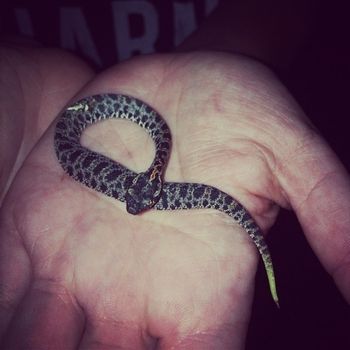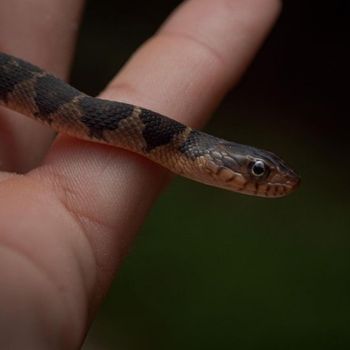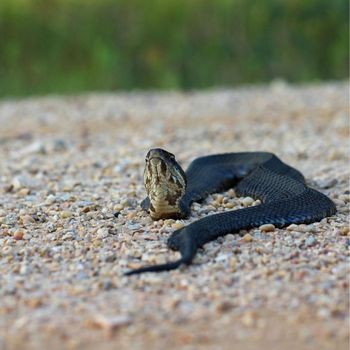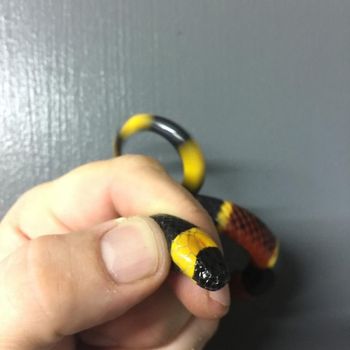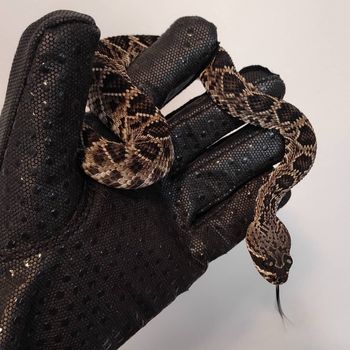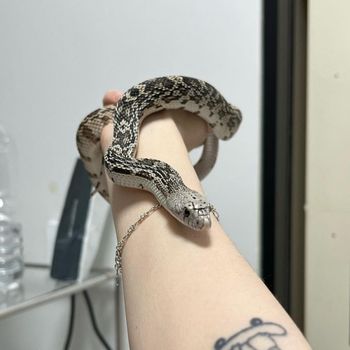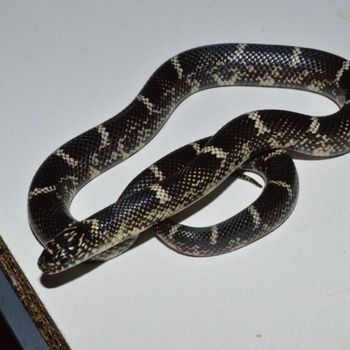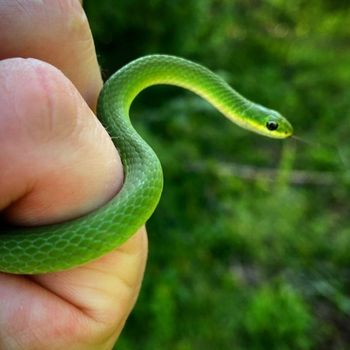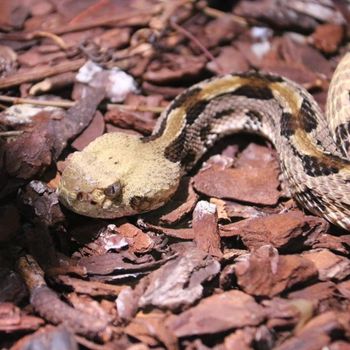Snakes in North Carolina: Serpents You Can’t Miss
As a fellow nature enthusiast, I’m sure you’ve heard about the impressive biodiversity found in North Carolina. From its stunning Appalachian Mountains to the beautiful coastline, this state has a little bit of everything — including snakes!
Although some might be a bit frightened by these slithery creatures, snake sightings are actually a great opportunity to learn more about the state’s wildlife. In fact, North Carolina is home to a whopping 38 native species of snakes!
In this article, we’ll be delving into ten of these intriguing species that you just might stumble upon during your next adventure in the Tar Heel State. So, let’s slip into the world of North Carolina’s snakes and uncover their fascinating secrets together.
| # | Name | Details | Image |
| 1 | Carolina Pygmy Rattlesnake (Sistrurus miliarius miliarius) |
| 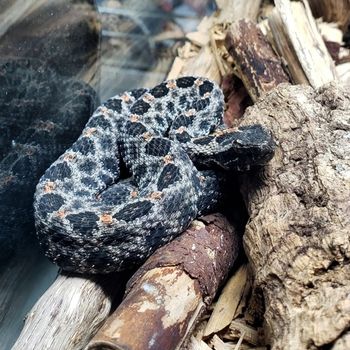 |
| 2 | Carolina Watersnake (Nerodia sipedon williamengelsi) |
| 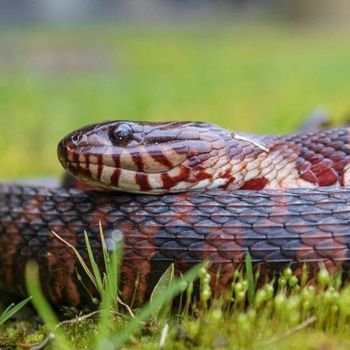 |
| 3 | Copperhead (Agkistrodon contortrix) |
| 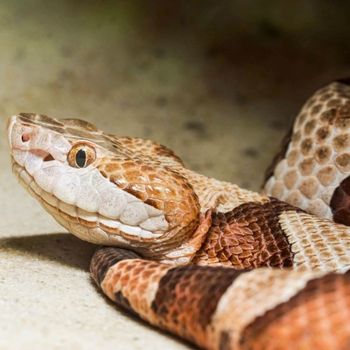 |
| 4 | Cottonmouth (Agkistrodon piscivorus) |
| 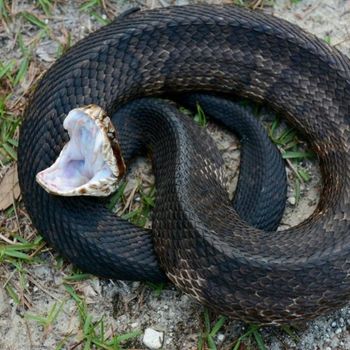 |
| 5 | Eastern Coral Snake (Micrurus fulvius) |
| 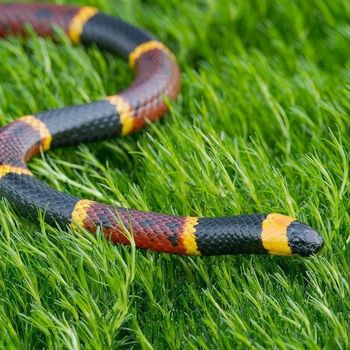 |
| 6 | Eastern Diamondback Rattlesnake (Crotalus adamanteus) |
| 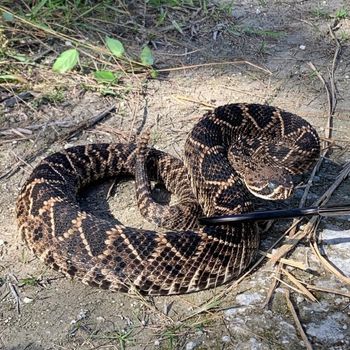 |
| 7 | Northern Pine Snake (Pituophis melanoleucus) |
| 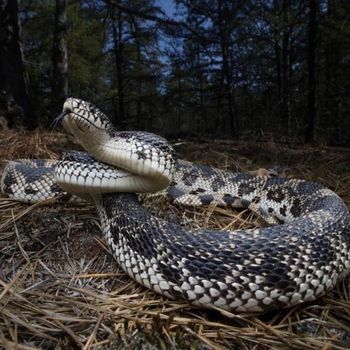 |
| 8 | Outer Banks Kingsnake (Lampropeltis getula sticticeps) |
| 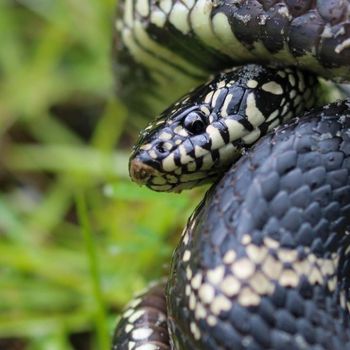 |
| 9 | Smooth Green Snake (Opheodrys vernalis) |
| 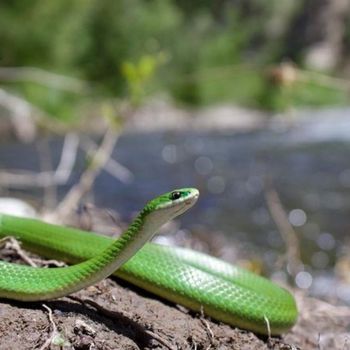 |
| 10 | Timber Rattlesnake (Crotalus horridus) |
|  |
10 Snakes You Can Find in North Carolina
In the state of North Carolina, a fascinating array of serpents can be found slithering through its diverse landscapes. From venomous to harmless, each species has its unique story to tell. Below, we’ll explore the wonders of these often misunderstood creatures of North Carolina, from their natural habitats and behaviors to the challenges they face in our changing world.
1. Carolina Pygmy Rattlesnake
- Scientific Name: Sistrurus miliarius miliarius
- Common Name: Carolina pygmy rattlesnake
- Size: Up to 2 feet (61 centimeters)
- Natural Habitat: Pine forests, hardwood forests, and mixed woodlands
- Color: Gray or brown with dark blotches
- Habitat: Pine forests, hardwood forests, and mixed woodlands
- Maximum Size: Up to 2 feet (61 centimeters)
- Diet: Small rodents, lizards, and insects
- Reproduction: Live-bearing; 1-8 offspring
- Venom: Venomous, but not considered life-threatening to humans
- Conservation: Least concern
The Carolina Pygmy Rattlesnake (Sistrurus miliarius miliarius) is a small venomous snake found in pine and hardwood forests and mixed woodlands. It grows up to 2 feet (61 centimeters) in length and sports a gray or brown color with dark blotches. This ambush predator is crepuscular, primarily feeding on small rodents, lizards, and insects. As a live-bearing species, it produces 1-8 offspring at a time. Although venomous, its bite is typically not life-threatening to humans. Its conservation status is least concern.
2. Carolina Watersnake
- Scientific Name: Nerodia sipedon williamengelsi
- Common Name: Carolina watersnake
- Size: Up to 2-3.5 feet (0.6-1.1 meters)
- Natural Habitat: Aquatic habitats, including swamps, marshes, and streams
- Color: Brown, gray or olive with dark bands
- Habitat: Aquatic habitats, including swamps, marshes, and streams
- Maximum Size: Up to 2-3.5 feet (0.6-1.1 meters)
- Diet: Fish, amphibians, and invertebrates
- Reproduction: Lays eggs in clutches of 12-30
- Venom: Non-venomous
- Conservation: Not evaluated
The Carolina Watersnake (Nerodia sipedon williamengelsi) is a non-venomous, nocturnal, semiaquatic snake that inhabits aquatic environments such as marshes, swamps, and streams. They can grow up to 2-3.5 feet (0.6-1.1 meters) in length and exhibit brown, gray, or olive-colored scales with dark bands. Their diet primarily consists of fish, amphibians, and invertebrates. The Carolina Watersnake reproduces by laying clutches of 12-30 eggs, and its conservation status has not been evaluated.
3. Copperhead
- Scientific Name: Agkistrodon contortrix
- Common Name: Copperhead
- Size: Up to 3 feet (0.9 meters)
- Natural Habitat: Forests, swamps, rocky terrain, and riverside habitats
- Color: Coppery-brown with reddish-brown or dark hourglass-shaped bands
- Habitat: Forests, swamps, rocky terrain, and riverside habitats
- Maximum Size: Up to 3 feet (0.9 meters)
- Diet: Rodents, birds, frogs, and insects
- Reproduction: Give live birth to 2-18 young in late summer or early fall
- Venom: Venomous, but relatively mild compared to other venomous snakes
- Conservation: Least concern
The Copperhead (Agkistrodon contortrix) is a venomous snake up to 3 feet (0.9 meters) long, known for its coppery-brown coloring with reddish-brown or dark hourglass-shaped bands. Inhabiting forests, swamps, rocky terrain, and riverside habitats, these solitary and primarily nocturnal creatures prey on rodents, birds, frogs, and insects. Copperheads give live birth to 2-18 young in late summer or early fall. Though venomous, their venom is relatively mild compared to other venomous snakes. Their conservation status is of least concern.
4. Cottonmouth
- Scientific Name: Agkistrodon piscivorus
- Common Name: Cottonmouth, water moccasin
- Size: 30-48 inches (76-122 cm)
- Natural Habitat: Swamps, marshes, rivers, and ponds
- Color: Olive, brown, or black with dark bands
- Habitat: Swamps, marshes, rivers, and ponds
- Maximum Size: 30-48 inches (76-122 cm)
- Diet: Fish, amphibians, rodents, birds, and other reptiles
- Reproduction: Give birth to live young (ovoviviparous), 1-16 offspring
- Venom: Venomous, hemotoxic venom
- Conservation: Least concern
The Cottonmouth (Agkistrodon piscivorus), also known as Water Moccasin, is a venomous snake measuring 30-48 inches (76-122 cm) in length. It features an olive, brown, or black coloration with dark bands. These semi-aquatic, nocturnal reptiles inhabit swamps, marshes, rivers, and ponds. Notably aggressive when threatened, their diet consists of fish, amphibians, rodents, birds, and other reptiles. Cottonmouths give birth to live young (ovoviviparous), producing 1-16 offspring. Their venom is hemotoxic, but their conservation status remains of least concern.
5. Eastern Coral Snake
- Scientific Name: Micrurus fulvius
- Common Name: Eastern coral snake
- Size: Up to 3 feet (0.9 meters)
- Natural Habitat: Forests, marshes, and wooded areas
- Color: Red, yellow, and black bands
- Habitat: Forests, marshes, and wooded areas
- Maximum Size: Up to 3 feet (0.9 meters)
- Diet: Small snakes, lizards, frogs, and rodents
- Reproduction: Lay eggs in clutches of 3-12
- Venom: Highly venomous
- Conservation: Least concern
The Eastern Coral Snake (Micrurus fulvius) is a species of venomous snake adorned with colorful red, yellow, and black bands. This shy, secretive creature reaches up to 3 feet (0.9 meters) in length and is commonly found in forests, marshes, and wooded areas. Though they tend to burrow, Eastern Coral Snakes primarily feed on small snakes, lizards, frogs, and rodents. As part of their reproductive process, they lay eggs in clutches of 3-12. Although highly venomous, their conservation status remains one of least concern.
6. Eastern Diamondback Rattlesnake
- Scientific Name: Crotalus adamanteus
- Common Name: Eastern diamondback rattlesnake
- Size: Up to 8 feet (2.4 meters)
- Natural Habitat: Dry forests, scrub, and coastal areas
- Color: Brown, yellow, and gray with diamond-shaped patterns
- Habitat: Dry forests, scrub, and coastal areas
- Maximum Size: Up to 8 feet (2.4 meters)
- Diet: Rodents, rabbits, small mammals, and birds
- Reproduction: Ovoviviparous, giving birth to 6-21 live young
- Venom: Venomous, potentially dangerous to humans
- Conservation: Least concern
The Eastern Diamondback Rattlesnake (Crotalus adamanteus) is a large, venomous serpent found primarily in dry forests, scrublands, and coastal areas. Reaching up to 8 feet (2.4 meters) in length, they exhibit a distinct coloration of brown, yellow, and gray with diamond-shaped patterns. These nocturnal and terrestrial predators primarily feed on rodents, rabbits, small mammals, and birds. Eastern Diamondbacks are ovoviviparous, giving birth to 6-21 live young. Although their venom is potentially dangerous to humans, their conservation status remains listed as least concern.
7. Northern Pine Snake
- Scientific Name: Pituophis melanoleucus
- Common Name: Northern pine snake
- Size: Up to 6 feet (1.8 meters)
- Natural Habitat: Dry, sandy habitats, such as pine forests and coastal dunes
- Color: White or yellowish with black or brown blotches
- Habitat: Dry, sandy habitats, such as pine forests and coastal dunes
- Maximum Size: Up to 6 feet (1.8 meters)
- Diet: Rodents, birds, and eggs
- Reproduction: Lay eggs in clutches of 5-12
- Venom: Non-venomous
- Conservation: Least concern
The Northern Pine Snake (Pituophis melanoleucus) is a large, non-venomous reptile, reaching up to 6 feet (1.8 meters) in length. Its distinct white or yellowish scales feature black or brown blotches. This burrowing, diurnal species thrives in dry, sandy habitats like pine forests and coastal dunes, where it feeds on rodents, birds, and eggs. Mating results in egg clutches of 5-12, and despite habitat loss, the species’ conservation status is currently classified as “least concern.”
8. Outer Banks Kingsnake
- Scientific Name: Lampropeltis getula sticticeps
- Common Name: Outer banks kingsnake
- Size: Up to 4 feet (1.2 meters)
- Natural Habitat: Coastal habitats, swamps, forests, and grasslands
- Color: Black or dark brown with yellow or white bands
- Habitat: Coastal habitats, swamps, forests, and grasslands
- Maximum Size: Up to 4 feet (1.2 meters)
- Diet: Rodents, amphibians, lizards, and eggs
- Reproduction: Lay eggs in clutches of 3-12
- Venom: Non-venomous
- Conservation: Not evaluated (likely least concern)
The Outer Banks Kingsnake (Lampropeltis getula sticticeps) is a non-venomous snake species that can grow up to 4 feet (1.2 meters) in length. They have black or dark brown skin adorned with yellow or white bands. These snakes that call North Carolina its home primarily inhabit coastal environments, swamps, forests, and grasslands. As nocturnal, terrestrial creatures, they feed on rodents, amphibians, lizards, and eggs. Females lay clutches of 3-12 eggs during reproduction. Although not evaluated, their conservation status is likely to be of least concern.
9. Smooth Green Snake
- Scientific Name: Opheodrys vernalis
- Common Name: Smooth green snake
- Size: 14-20 inches (36-51 cm)
- Natural Habitat: Grasslands, meadows, and open woodlands
- Color: Bright green with a lighter belly
- Habitat: Grasslands, meadows, and open woodlands
- Maximum Size: 14-20 inches (36-51 cm)
- Diet: Insects and spiders
- Reproduction: Lay eggs in clutches of 3-12
- Venom: Non-venomous
- Conservation: Least concern
The Smooth Green Snake (Opheodrys vernalis) measures 14-20 inches (36-51 cm) and is characterized by its vibrant green color and lighter belly. Commonly found in grasslands, meadows, and open woodlands, this diurnal and terrestrial reptile is an adept climber. Its diet mainly consists of insects and spiders. In terms of reproduction, they lay eggs in clutches of 3-12. Though non-venomous, these snakes should be admired from afar. Fortunately, their conservation status is currently listed as ‘Least Concern.’
10. Timber Rattlesnake
- Scientific Name: Crotalus horridus
- Common Name: Timber rattlesnake
- Size: Up to 6 feet (1.8 meters)
- Natural Habitat: Forests, mixed woodlands, and rocky hillsides
- Color: Yellow, brown, gray, or black with dark bands
- Habitat: Forests, mixed woodlands, and rocky hillsides
- Maximum Size: Up to 6 feet (1.8 meters)
- Diet: Rodents, birds, and small mammals
- Reproduction: Viviparous, giving birth to 4-14 live young
- Venom: Hemotoxic venom
- Conservation: Least concern
The Timber Rattlesnake, scientifically known as Crotalus horridus, is a solitary, ambush predator that can grow up to 6 feet (1.8 meters) in length. It comes in various colors, including yellow, brown, gray, or black with dark bands, and inhabits forests, mixed woodlands, and rocky hillsides. Its diet consists of rodents, birds, and small mammals. Unlike most snakes, the Timber Rattlesnake is viviparous, giving birth to 4-14 live young. It possesses hemotoxic venom, and its conservation status is currently listed as least concern.
Nearby States:
Do Any Snake Species Found in Minnesota Also Inhabit North Carolina?
Yes, there are snakes native to minnesota species that can also be found in North Carolina. For example, the common garter snake inhabits both states due to their similar temperate environments. These adaptable reptiles thrive in a variety of habitats, from woodlands to grasslands, across different regions.
Final Words
All the 10 snakes have truly opened our eyes to the fascinating world of snakes found in North Carolina. Who knew there were so many different types of these slithering reptiles, each with their own unique characteristics and habitats?
Not only did we get a chance to learn about some of the more common and well-known species, but we also delved into the lesser-known and often misunderstood ones.
So, the next time you’re out and about in North Carolina, keep an eye out for these incredible creatures, and let’s continue to appreciate and protect the diverse wildlife that makes our world so interesting!


